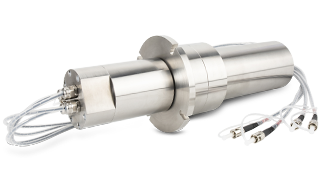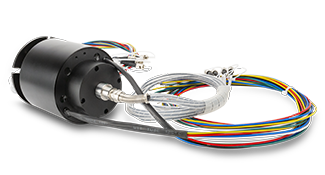RF & Optic Rotary Joints
What is a Rotary Joint?
A rotary joint is an instrument which is employed with the purpose of transferring either liquids or gases which are either under pressure or located within a vacuum.
These fluids are being transferred from a fixed inlet over to a revolving outlet whilst both maintaining and segregating the fluid contact, the device is largely responsible for providing a seal between the moving and stationary parts.
On the market there are many different types of rotary unions available today for you to purchase however having the knowledge of each will benefit you when you come to make the choice of which to buy.
Rotary Joints
Learn More About Rotary Joints
Design
Rotary joints come in various shapes and sizes. Each rotary joint has differing configurations. The way in which your rotary joint looks is largely dependent on the purpose it is needed for.
However, although they have many different applications rotary joints share some common features aesthetically. The most common of these features being all rotary joints have both a housing unit and a shaft.
It is the shaft which carries fluid media through the union and it is the housing which ensures the rotary union and fluid media transfer remains intact.
Without these vital components, any rotary joint simply would be able to fulfil their purpose of transferring fluid media from one destination to another without any leaks.
Rotary Joint Components
Now I have discussed the different types of rotary unions available on the market, I will now cover the basic components which make up each Rotary Union.
Although it is a possibility that all rotary unions differ in the way they look, they are all comprised of the same core features.
Each individual rotary union is comprised of four essential components:
The housing: The part of the rotary union which does not move and is connected to the main media supply.
Bearings: The revolving part of the union is supported by spiral bearings, usually comprised of one or more completely sealed deep-groove bearings.
The shaft: A self-sufficient component which revolves with the rotary equipment to which it is connected.
Seals: The most important part of the rotary union, they are solely responsible for preventing any leak from the fixed and revolving components.
Usually, leakage can be prevented but this is not always the case.
In some applications, a 100% leak-free transfer is not a realistic target. In this situation the fluid media is collected within a collection system to prevent it from getting into the air we breathe.
How a Rotary Joint works?
A rotary joint will lock onto and seal any input valve whilst it is revolving to connect it to an outlet. The way in which it does so is by using varying amounts of pressure.
Low-pressure or a vacuum is dependent on the overall spring force which creates the seal. Whilst the rotary joint is in the process of fixing to the outlet the fluid media will then stream into the said rotary joint from its original source.
It will then be stored within the device during its movement to prevent leakage.
Rotary Joint Application
Rotary Joints have many applications and I have discussed some in the guide so far, however, I will now cover other common applications.
We find rotary joints in basically any industrial environment today; they are used in all situations where a type of fluid media needs to be transferred across rotating components.
A proportion of rotary joints are developed in a way so that they are customized for a specific application. This largely depends on the needs of the individual consumer and the list of possibilities is endless, as such they will not be covered here.
Agriculture
Found in equipment used for harvesting crops such as grain. Rotary unions are located within the machinery used in the harvesting process.
Automotive
Used in various operation which requires a coolant such as manufacturing glass or plastic.
Car Washes
Low-pressure water is fed through the supporting shaft of the rotary union into the brushes
Steel Industry
The Steel industry is arguably the largest of all industries which employ the use of rotary unions.
They do so as numerous rotary unions are needed for CCM machines (continuous casting machines). These machines employ rotary unions to cool down the many rolls which reinforce smelted slabs before they move through other parts of the machine.
Do you wholesale rotary joint?
Yes, we can. Our rotary joint price is affordable. you can contact us and buy a rotary joint now
©2022 Orbinexus . All rights reserved Site Map
 Pay Online
Pay Online Get A
Quote
Get A
Quote Deutsch
Deutsch


